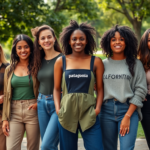Fashion has always been more than just a means to cover our bodies; it is a powerful tool for self-expression and social commentary. One of the most intriguing intersections in modern culture is where fashion meets activism. By understanding this unique symbiosis, we can appreciate how style can be a potent medium for conveying messages and sparking conversations on important issues. In this article, we will delve into how fashion is used as a form of activism, exploring its history, significant movements, and its role today.
The Historical Context of Fashion as Activism

Fashion has been used as a platform for activism for centuries. From the suffragettes who donned white dresses to symbolize their purity and righteousness, to the Black Panthers who wore black leather jackets and berets to project unity and strength, fashion has consistently been utilized to communicate powerful messages. These historical moments highlight how clothing has been strategically selected to make political and social statements, thereby embedding the very fabric of activism into our wardrobe choices.
Iconic Fashion Movements and Their Impact
Several fashion movements have left an indelible mark on society. For example:
-
Punk Rock:
Emerging in the 1970s, punk fashion included items like ripped jeans, leather jackets, and band T-shirts. It was more than a style—it was a rebellion against societal norms and an assertion of individuality. -
Black Lives Matter:
More recently, the Black Lives Matter movement has seen activists wearing T-shirts, masks, and even formal wear emblazoned with messages supporting racial justice. These garments are not just outfits but statements demanding equality and systemic change. -
Sustainable Fashion:
This movement advocates for eco-friendly materials and ethical manufacturing processes. Fashion brands and consumers alike are making a stand against fast fashion by opting for sustainable choices.
These movements have not only shaped fashion trends but have also influenced societal attitudes and policymaking.
Role of Social Media in Amplifying Fashion Activism
In today’s digital age, social media platforms like Instagram and TikTok have become crucial in amplifying fashion activism. Influencers and activists can reach millions of people with a single post, thereby generating awareness and inspiring action. Hashtags such as #MeToo and #FashionRevolution have garnered global attention, linking fashion directly to social causes. The visual nature of these platforms makes them perfect for showcasing activist fashion, transforming style choices into viral statements.
Brands Taking a Stand
Modern fashion brands are increasingly realizing the importance of aligning with social causes. Brands like Patagonia and TOMS have woven activism into their business models. Patagonia donates a portion of its profits to environmental causes, while TOMS’ one-for-one model provides shoes to those in need. By supporting these brands, consumers not only buy products but also contribute to broader social and environmental initiatives.
Many luxury brands are also stepping up. Gucci, for example, has launched campaigns aimed at gender equality and mental health awareness. These efforts show that activism in fashion isn’t limited to grassroots movements; it can also be supported by top-tier industry players.
The Future of Fashion Activism
Looking forward, the future of fashion activism appears promising. As consumers become more socially conscious, the demand for ethically-made and purpose-driven fashion is expected to rise. Emerging designers are increasingly focused on creating collections that are not only stylish but also advocate for various social causes.
Technological advancements, such as blockchain, are also facilitating greater transparency in the supply chain, making it easier for consumers to support brands that align with their values. It’s clear that the fusion of fashion and activism is not a passing trend but a movement that will continue to evolve.
Conclusion
Fashion and activism are two powerful forces that, when combined, can create lasting change. From historical moments to modern-day movements, style has been used to make bold statements and push for social justice. As we move toward a more conscious and interconnected world, the role of fashion in activism is only set to grow. Dress not just for the occasion but for the change you wish to see in the world.
FAQs
1. What is fashion activism?
Fashion activism is the practice of using clothing and style to promote social, political, and environmental causes. It blends fashion with advocacy, using garments to make statements and inspire change.
2. How has fashion been used in historical movements?
Throughout history, fashion has been a medium for social commentary. For example, the suffragettes wore white dresses to symbolize their purity and determination. Similarly, the Black Panthers used their distinctive black outfits to project strength and unity.
3. Can brands effectively combine fashion and activism?
Yes, many brands have successfully integrated activism into their business models. Examples include Patagonia, which supports environmental causes, and TOMS, known for its one-for-one giving model. Aligning with social causes can enhance brand loyalty and consumer trust.
Social media platforms like Instagram and TikTok amplify fashion activism by allowing users to share activist-oriented outfits and messages with a global audience. Hashtags and viral posts can quickly generate widespread awareness and support for various causes.
5. What is the future of fashion activism?
The future of fashion activism looks bright as consumers become more socially conscious. Emerging technologies like blockchain are enhancing supply chain transparency, and designers are increasingly focusing on creating ethical, purpose-driven collections that advocate for social change.





